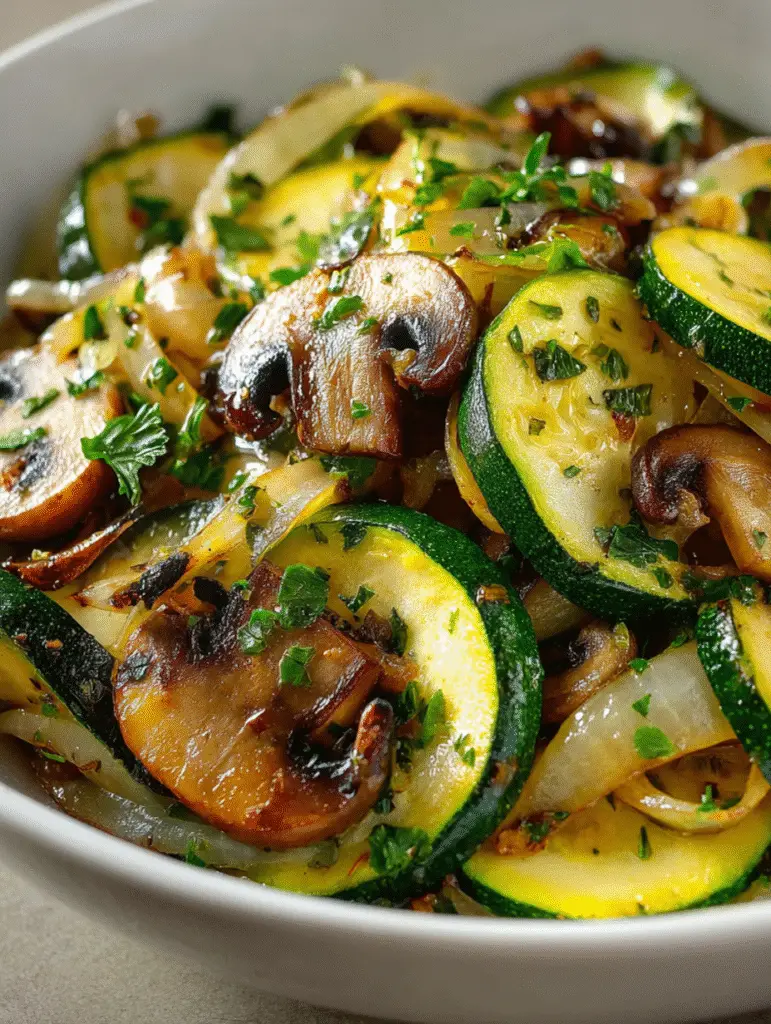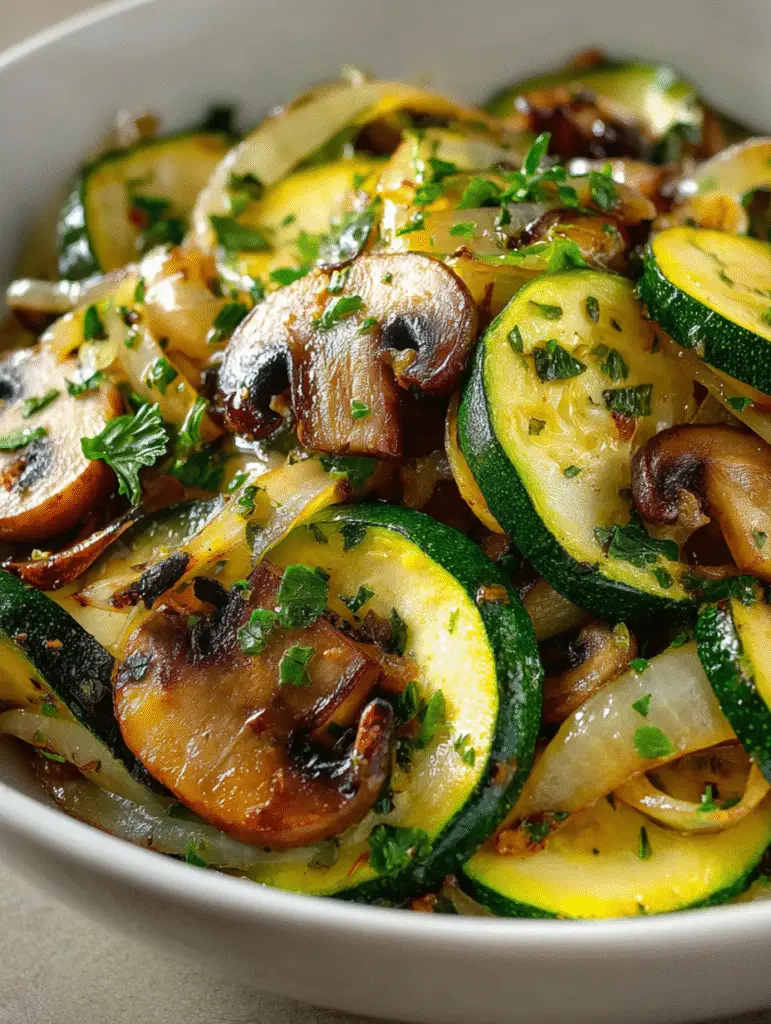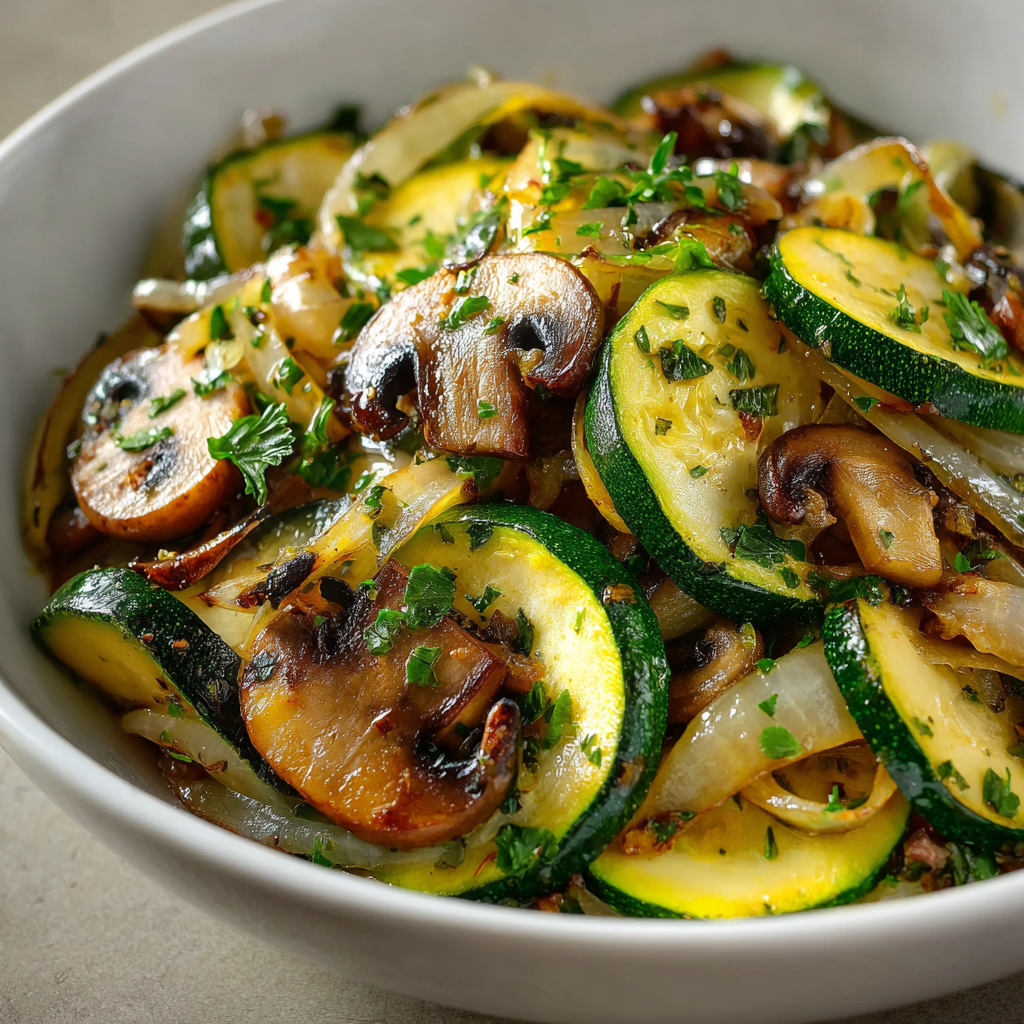Prep Time: 10 minutes
Cook Time: 10 minutes
Total Time: 20 minutes
Course: Side Dish
Cuisine: American
Servings: 4 people
Calories: 120 kcal per serving
Growing up in my grandmother’s kitchen, I learned that the simplest dishes often become the most memorable. She’d pull fresh zucchini from her garden, grab whatever mushrooms looked good at the market, and create this magical side dish that somehow made everyone ask for seconds. Years later, when I moved into my first apartment, this became my go-to recipe whenever I needed something quick, healthy, and impressive enough to serve guests. The beauty lies in how three humble vegetables transform into something greater than the sum of their parts.
What makes this dish so special is its versatility and speed. In just twenty minutes, you can create a colorful, nutrient-packed side that works with virtually any main course. The zucchini maintains a pleasant bite, the mushrooms develop a rich, earthy depth, and the onions add sweetness that ties everything together. It’s become my secret weapon for those nights when I need dinner on the table fast but refuse to compromise on flavor or nutrition.
Why This Veggie Medley Will Become Your Favorite
Twenty-minute total time makes this ideal for busy weeknights when cooking feels overwhelming. From the moment you start slicing vegetables to plating the finished dish, you’ll spend less time than it takes to order and pick up takeout. The hands-on cooking time is minimal, giving you freedom to prepare other components of your meal simultaneously.
Naturally healthy and diet-friendly means this dish works for virtually every eating style. It’s naturally vegetarian, vegan, gluten-free, paleo, keto, and Whole30 compliant without any modifications. At just 120 calories per serving, it provides substantial nutrition without weighing you down or derailing any health goals you’re working toward.
Fresh vegetables shine through when cooked with this simple technique that enhances rather than masks their natural flavors. Unlike heavy, sauce-laden sides, this preparation lets you taste the sweet, mild zucchini, the meaty mushrooms, and the caramelized onions individually while they harmonize on your palate. The olive oil and garlic add richness without overwhelming the vegetables.
Infinitely customizable base allows you to adapt this recipe to whatever’s in your refrigerator or available at the market. Bell peppers, cherry tomatoes, spinach, or yellow squash all work beautifully with this method. The basic technique remains the same while the flavor profile shifts based on your additions, making it a recipe you’ll never tire of.
Budget-friendly ingredients mean you can make this anytime without special shopping trips or breaking the bank. Zucchini, mushrooms, and onions are affordable year-round, though they’re especially economical during summer when zucchini floods farmers’ markets. One recipe costs just a few dollars but looks and tastes like something from an upscale restaurant.
Equipment You’ll Need
- 1 large skillet or frying pan – A 12-inch pan provides enough space for vegetables to sauté rather than steam
- 1 cutting board – Preferably a large one to hold all your prepped vegetables
- Measuring cups and spoons – For precise olive oil and seasoning amounts
- Sharp chef’s knife – Makes vegetable prep quick and effortless
- Wooden spoon or spatula – For stirring without scratching your pan
Ingredients You’ll Need
Main Vegetables
- 2 medium zucchinis, sliced into half-moons (about 1 pound) – Choose firm zucchini without soft spots
- 8 ounces mushrooms, sliced – Button or cremini varieties work best; avoid pre-sliced for better texture
- 1 medium onion, thinly sliced – Yellow, white, or sweet onions all work beautifully
Flavor Enhancers
- 2 tablespoons olive oil – Extra virgin adds the best flavor
- 2 cloves garlic, minced – Fresh garlic is essential; jarred doesn’t provide the same aromatic quality
- Salt to taste – Start with 1/2 teaspoon and adjust from there
- Black pepper to taste – Freshly ground provides superior flavor
- 1 teaspoon dried thyme (optional) – Adds an earthy, slightly floral note
Garnish
- Fresh parsley, chopped (optional) – Brightens the dish visually and adds fresh herb flavor
Step-by-Step Instructions
Prepare Your Vegetables
Begin by washing all your vegetables thoroughly under cool running water. Pat the zucchinis and mushrooms dry with paper towels—excess moisture prevents proper browning and can make your vegetables soggy. Slice the zucchinis into half-moon shapes about 1/4 inch thick by first cutting them in half lengthwise, then slicing across. This shape provides optimal surface area for caramelization while maintaining enough structure to stay firm during cooking.
For the mushrooms, use a damp paper towel to wipe away any dirt rather than rinsing them under water. Mushrooms absorb moisture like sponges, which interferes with browning. Slice them about 1/4 inch thick, keeping the pieces relatively uniform so they cook evenly. Peel the onion, cut it in half from root to stem, then slice each half thinly from the cut side. Finally, mince your garlic cloves finely—the smaller the pieces, the more evenly the flavor distributes throughout the dish.
Heat Your Pan Properly
Place your large skillet over medium heat and add the olive oil, swirling to coat the bottom of the pan evenly. Allow the oil to heat for about one minute until it shimmers but doesn’t smoke. This proper heating is crucial—too cool and your vegetables will steam instead of sauté, while too hot will burn the outside before cooking the inside. You can test if it’s ready by adding one small piece of onion; it should sizzle immediately upon contact.
Sauté the Onions First
Add all the sliced onions to your heated skillet in an even layer. The key here is patience—resist the urge to stir constantly. Let the onions sit for about 60 seconds before stirring, allowing them to develop some caramelization. Continue cooking for about 3 minutes total, stirring occasionally, until the onions soften and become translucent with lightly golden edges. The natural sugars in the onions will begin to caramelize, creating a sweet foundation for the other vegetables.
Add Garlic and Mushrooms
Once your onions have softened, add the minced garlic to the pan and stir for about 30 seconds until fragrant. Be careful not to let it burn, as garlic goes from perfect to bitter very quickly. Immediately add the sliced mushrooms to the skillet, spreading them out as much as possible. Initially, the mushrooms will absorb the oil and seem dry, but don’t add more oil—they’ll release moisture as they cook.
Sauté the mushrooms for 3-4 minutes, stirring occasionally to ensure even cooking. You’ll notice them shrinking and darkening as they release their liquid. Continue cooking until they’re tender and most of their moisture has evaporated, concentrating their earthy, umami-rich flavor. The mushrooms should develop golden-brown edges, indicating proper caramelization.
Incorporate the Zucchini
Add the sliced zucchini to your skillet along with salt, black pepper, and thyme if using. Stir everything together to combine evenly. The zucchini will be quite firm at first, which is exactly what you want. Sauté for 3-5 minutes, stirring frequently to ensure all pieces cook evenly and develop some light browning on the edges.
The zucchini is done when it’s tender but still has a slight firmness—you should be able to pierce it easily with a fork, but it shouldn’t be mushy. Overcooking zucchini turns it watery and unpleasant, so watch carefully during these final minutes. The vegetables should glisten with oil and release an irresistible aroma of garlic and herbs.
Final Seasoning and Serving
Taste your vegetables and adjust the seasoning as needed. Sometimes vegetables need more salt than you expect to really bring out their flavors, so don’t be shy about adding another pinch. Remove the pan from heat immediately to prevent overcooking from residual heat. Transfer the sautéed vegetables to a serving dish, garnish with freshly chopped parsley if desired, and serve while still warm for the best texture and flavor.

Serving Suggestions for Every Meal
This versatile side dish pairs beautifully with grilled chicken breasts or thighs for a complete, balanced dinner. The light, fresh vegetables complement the charred, smoky flavors from the grill without competing for attention. Add a starch like roasted potatoes or crusty bread to round out the meal.
Serve these vegetables alongside pan-seared salmon or any white fish for an elegant seafood dinner. The earthy mushrooms and mild zucchini won’t overpower delicate fish flavors, while the garlic adds just enough boldness to make the plate interesting. A squeeze of fresh lemon over everything brings brightness that ties the components together.
For a vegetarian main course, serve these vegetables over quinoa, brown rice, or farro with a poached or fried egg on top. The runny yolk creates a rich sauce that coats the grains and vegetables beautifully. Add some crumbled feta cheese or toasted pine nuts for extra protein and textural contrast.
These vegetables also work wonderfully as a topping for grilled steak or pork chops. The vegetables’ lightness balances the richness of red meat, while their moisture helps cut through any fattiness. This combination feels indulgent yet healthy at the same time.
Consider serving this as part of a mezze-style spread with hummus, baba ganoush, pita bread, and olives. The Mediterranean flavors complement each other perfectly, creating a casual yet impressive meal for entertaining.
Creative Variations to Try
Italian-Inspired Version
Add halved cherry tomatoes during the last 2 minutes of cooking and finish with fresh basil instead of parsley. A sprinkle of Parmesan cheese and a drizzle of balsamic reduction transforms this into an Italian classic. The acidity from tomatoes brightens everything while the cheese adds umami depth.
Asian-Style Twist
Replace olive oil with sesame oil and add a tablespoon of soy sauce or tamari during the last minute of cooking. Finish with toasted sesame seeds and sliced green onions. For extra dimension, add a teaspoon of fresh grated ginger along with the garlic.
Mexican-Flavored Option
Season with cumin and chili powder instead of thyme, and add diced poblano pepper along with the onions. Finish with fresh cilantro and a squeeze of lime juice. These vegetables make an excellent filling for tacos or quesadillas.
Mediterranean Addition
Add sliced Kalamata olives and sun-dried tomatoes during the last minute of cooking. Finish with crumbled feta cheese and fresh oregano. This version pairs exceptionally well with grilled lamb or chicken souvlaki.
Hearty Winter Variation
Add diced bell peppers in multiple colors and swap the thyme for rosemary. Include a handful of baby spinach at the very end, allowing it to just wilt. This more robust version stands up well to colder weather and heartier main dishes.
Make-Ahead Tips for Meal Prep
The vegetables can be washed, sliced, and stored separately in airtight containers in the refrigerator for up to 2 days before cooking. Keep the zucchini separate from the mushrooms and onions, as zucchini releases moisture that can make the mushrooms soggy. This prep work cuts your active cooking time to just 10 minutes when you’re ready to eat.
While this dish tastes best freshly made, leftovers store surprisingly well in an airtight container for up to 3 days in the refrigerator. The texture will soften slightly upon reheating, but the flavor remains delicious. Reheat gently in a skillet over medium heat rather than the microwave to help restore some of the original texture.
For meal prep purposes, you can cook a double batch at the beginning of the week and portion it into individual containers. Add it to grain bowls, omelets, or wraps throughout the week for quick, healthy meals. The vegetables provide instant nutrition and flavor to otherwise simple dishes.
If you’re entertaining, you can cook these vegetables up to 2 hours ahead and leave them at room temperature. Reheat briefly in the skillet just before serving, or serve them at room temperature as part of a Mediterranean spread. They’re delicious warm or at room temperature, though I wouldn’t recommend serving them cold.
To freeze these vegetables, slightly undercook them, let them cool completely, then freeze in portion-sized containers for up to 3 months. Thaw in the refrigerator overnight and reheat in a skillet. While the texture won’t be quite as good as fresh, it’s a convenient option for batch cooking.
Important Cooking Notes
Don’t overcrowd your pan, as this is the most common mistake that leads to soggy, steamed vegetables instead of beautifully sautéed ones. If your skillet isn’t large enough to hold all the vegetables in a relatively single layer, cook them in two batches. The extra few minutes is worth it for properly caramelized results.
Medium heat is your friend for this recipe, as it provides enough heat to caramelize without burning. If you notice anything starting to brown too quickly or stick to the pan, reduce the heat slightly. Different stovetops vary in temperature, so watch your vegetables and adjust accordingly.
Add vegetables in order of cooking time, which is why we start with onions, then add mushrooms, and finish with zucchini. This technique ensures everything finishes cooking at the same time without some vegetables being mushy while others remain raw. Skipping this step results in unevenly cooked vegetables.
Customize with seasonal additions like bell peppers, cherry tomatoes, or baby spinach for variety. Summer squash, asparagus, or snap peas work beautifully in this basic sautéed vegetable method. The technique remains the same regardless of which vegetables you choose.
Fresh garlic makes a significant difference compared to pre-minced jarred garlic or garlic powder. The aromatic compounds in fresh garlic provide depth and complexity that dried or jarred versions simply can’t match. It’s worth the minimal extra effort of mincing it yourself.

Frequently Asked Questions
Can I use frozen vegetables instead of fresh?
While technically possible, frozen vegetables contain too much moisture for this cooking method and will result in a watery, steamed texture rather than caramelized sautéed vegetables. If you must use frozen, thaw them completely and pat very dry with paper towels before cooking. Fresh vegetables really are essential for the best results.
Why do my vegetables turn out soggy?
Soggy vegetables usually result from overcrowding the pan, cooking over too-low heat, or not drying the vegetables properly before cooking. Make sure your pan is large enough, the heat is truly at medium, and excess moisture is removed. Also, avoid stirring too frequently, as this prevents browning.
Can I make this dish oil-free?
For an oil-free version, use vegetable broth or water for sautéing, though the flavor and texture won’t be quite the same. You’ll need to stir more frequently and add liquid in small amounts as it evaporates. The vegetables won’t develop the same caramelization but will still taste good.
What type of mushrooms work best?
Button and cremini mushrooms are ideal because of their mild flavor and firm texture. Portobello mushrooms can work but should be sliced thinner. Avoid delicate mushrooms like oyster or enoki, as they’ll break down too much. Shiitake mushrooms add wonderful flavor but remove the tough stems first.
How do I know when the zucchini is perfectly cooked?
The zucchini should be tender enough to pierce easily with a fork but still have a slight firmness—it shouldn’t bend when you pick up a piece. The edges should have light golden-brown spots, indicating caramelization. This usually takes 3-5 minutes depending on how thickly you sliced them.
Can I add protein to make this a main dish?
Absolutely! Add cooked chicken, shrimp, Italian sausage, or chickpeas during the last 2-3 minutes of cooking to warm through. For a vegetarian option, crumbled tofu seasoned with the same spices works beautifully. This transforms the side dish into a complete one-pan meal.
What should I do with leftovers?
Leftover sautéed vegetables make excellent additions to frittatas, omelets, grain bowls, pasta, or pizza. You can also blend them into soup, chop them finely for a vegetable hash, or wrap them in a tortilla with some cheese for a quick quesadilla. They’re incredibly versatile for creative leftovers.
Why do I need to cook the vegetables in a specific order?
Different vegetables have different cooking times and moisture content. Onions take longest to soften and caramelize, mushrooms need time to release their moisture, and zucchini cooks quickly and can turn mushy if overcooked. Adding them in stages ensures everything finishes perfectly at the same time.
Nutrition Information (per serving):
Calories: 120 kcal | Fat: 7g | Carbohydrates: 12g | Fiber: 3g | Protein: 4g | Sodium: 300mg (varies with salt added)
Pro Tips for Success:
- Use the largest skillet you own to prevent overcrowding
- Keep vegetables moving in the pan but don’t stir constantly
- Taste and adjust seasoning at the end—vegetables often need more salt than expected
- Serve immediately for the best texture and flavor

